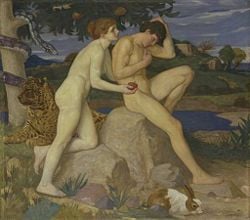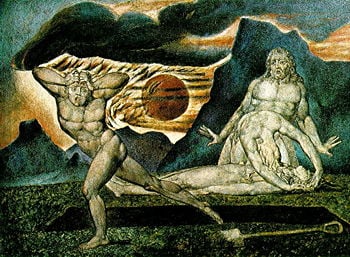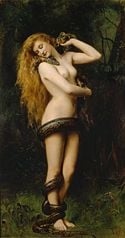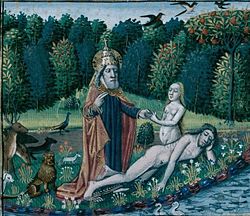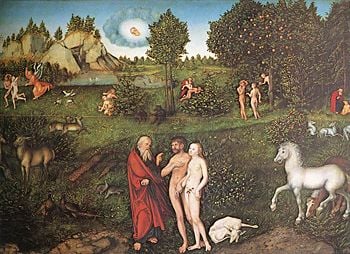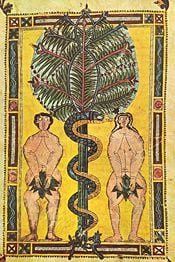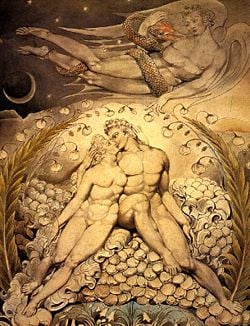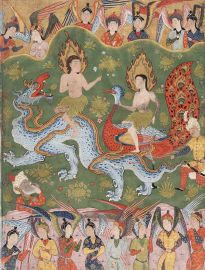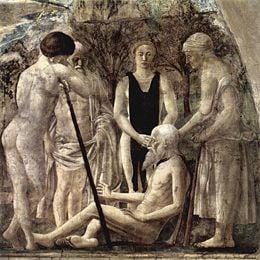Difference between revisions of "Adam and Eve" - New World Encyclopedia
m |
|||
| Line 10: | Line 10: | ||
==Biblical account== | ==Biblical account== | ||
===The creation of man and woman=== | ===The creation of man and woman=== | ||
| − | [[Image:God2-Sistine Chapel.png|400px|thumb|right|[[Michelangelo]]'s '' | + | [[Image:God2-Sistine Chapel.png|400px|thumb|right|[[Michelangelo]]'s ''Michelangelo shows God giving life to Adam, with Eve cradled under His arm.]] |
The story of Adam and Eve begins in the first chapter of the [[Book of Genesis]], but they are not refered to here by name. Instead, the text refers to God's deciding to "make man in our image, in our likeness." The creation of man takes place after six "days" of creation in which God first brings into being the heavens and the earth, light, day and night, sky and sea, dry land, trees and other vegetation, the sun and the moon, sea creatures and birds, and finally livestock and wild animals. The manifestation of God's image in "man" is both masculine and feminine: | The story of Adam and Eve begins in the first chapter of the [[Book of Genesis]], but they are not refered to here by name. Instead, the text refers to God's deciding to "make man in our image, in our likeness." The creation of man takes place after six "days" of creation in which God first brings into being the heavens and the earth, light, day and night, sky and sea, dry land, trees and other vegetation, the sun and the moon, sea creatures and birds, and finally livestock and wild animals. The manifestation of God's image in "man" is both masculine and feminine: | ||
| Line 24: | Line 24: | ||
===The fall of man=== | ===The fall of man=== | ||
| − | + | [[Image:Strang, The Temptation.jpg|thumb|250px|left|A modern depiction of Eve tempting Adam]] | |
| − | [[Image: | ||
For an unspecified period of time, Adam and Eve obey the one commandment they have been given, to refrain from eating of the [[forbidden fruit]]. However, one day, a [[serpent]] comes to Eve and seduces her into partaking of it. "God knows that when you eat of it your eyes will be opened," he tells her, "and you will be like God, knowing good and evil." The serpent shows Eve that the fruit is "good for food and pleasing to the eye, and also desirable for gaining wisdom," so she eats it. She then gives some of the fruit to Adam, and he, too, eats. Adam and Eve immediately realize that they are naked, and become of ashamed of this, using fig leaves to cover their sexual organs. | For an unspecified period of time, Adam and Eve obey the one commandment they have been given, to refrain from eating of the [[forbidden fruit]]. However, one day, a [[serpent]] comes to Eve and seduces her into partaking of it. "God knows that when you eat of it your eyes will be opened," he tells her, "and you will be like God, knowing good and evil." The serpent shows Eve that the fruit is "good for food and pleasing to the eye, and also desirable for gaining wisdom," so she eats it. She then gives some of the fruit to Adam, and he, too, eats. Adam and Eve immediately realize that they are naked, and become of ashamed of this, using fig leaves to cover their sexual organs. | ||
| Line 65: | Line 64: | ||
=== Christianity === | === Christianity === | ||
| − | + | The story of Adam and Eve forms the basis for the Christian doctrine of [[original sin]]: "Sin came into the world through one man and death through sin, and so death spread to all men because all men sinned," said [[Paul of Tarsus]] in his [[Epistle to the Romans]], writing in Greek about 58 C.E.<ref> Later theological commentators characterised Adam and Eve's disobedience to God's word as the foundation of sin. Nevertheless, Chapter 3 of Genesis does not use the word "sin", and Genesis 3:24 makes clear that they are expelled "lest he put forth his hand and take also of the tree of life, and eat, and live for ever".</ref> [[Image:Cranach.jpg|thumb|350px|God speaks to Adam and Eve, with various other scenes from their story in the background.]] [[St Augustine of Hippo]] (354-430), working with a Latin translation of the epistle, understood Paul to have said that Adam's sin was hereditary: "Death passed upon (i.e. spread to) all men because of Adam, [in whom] all sinned".<ref>For a brief overview see [[Robin Lane Fox]], "The Unauthorized Version", 1991, pp15-27 passim</ref> Original sin, the concept that man is born in a condition of sinfulness and must await redemption, became a cornerstone of Christian theological tradition, primarily in Western-rite churches, but is not shared by Judaism, the Orthodox churches,<ref>[http://www.stmaryorthodoxchurch.org/orthodoxy/articles/2004-hughes-sin.php Orthodox beliefs]</ref> nor by post-Reformation churches such as the Congregationalist churches, nor [[The Church of Jesus Christ of Latter-day Saints]]. | |
| − | The story of Adam and Eve forms the basis for the Christian doctrine of [[original sin]]: "Sin came into the world through one man and death through sin, and so death spread to all men because all men sinned," said [[Paul of Tarsus]] in his [[Epistle to the Romans]], writing in Greek about 58 C.E. | ||
| − | Over the centuries, a system of uniquely Christian beliefs has developed from the Adam and Eve story. [[Baptism]] has become understood as a means of washing away the stain of hereditary sin in some churches. In other branches of Christianity, baptism is a means of washing away sins that were actually committed by the person being baptised. It is an identification with the death, burial and resurrection of Jesus Christ. It is a ceremony of spiritually washing one in the blood of the Savior, which was shed on the cross. In still other Christian traditions, this process is merely seen as a symbol of faith and also an initiation, or a public declaration of faith.<ref>[http://www.newadvent.org/cathen/11312a.htm Original Sin]</ref> | + | Over the centuries, a system of uniquely Christian beliefs has developed from the Adam and Eve story. [[Baptism]] has become understood as a means of washing away the stain of hereditary sin in some churches. In other branches of Christianity, baptism is a means of washing away sins that were actually committed by the person being baptised. It is an identification with the death, burial and resurrection of Jesus Christ. [[Image:B Escorial 18.jpg|thumb|175px|left|Depiction of the ''original sin''. Illuminated parchment, Spain, circa 950-955 C.E.]] It is a ceremony of spiritually washing one in the blood of the Savior, which was shed on the cross. In still other Christian traditions, this process is merely seen as a symbol of faith and also an initiation, or a public declaration of faith.<ref>[http://www.newadvent.org/cathen/11312a.htm Original Sin]</ref> Additionally, the serpent that tempted Eve was interpreted by some to have been [[Satan]], although there is no mention of this identification in the Torah. Christian interpretations of the Scripture are often considered more literal than Jewish interpretations. |
Because Eve had tempted Adam to eat of the fatal fruit, some early [[Fathers of the Church]] held her and all subsequent women to be the first sinners, and especially responsible for the Fall. "You are the devil's gateway," [[Tertullian]] told his female listeners in the early 2nd century, and went on to explain that they were responsible for the death of Christ: "On account of your desert _ that is, death - even the Son of God had to die."<ref>[http://www.tertullian.org/anf/anf04/anf04-06.htm Tertullian, "De Cultu Feminarum", Book I Chapter I, ''Modesty in Apparel Becoming to Women in Memory of the Introduction of Sin Through a Woman'' (in "The Ante-Nicene Fathers")]</ref> In 1486 the [[Dominicans]] Kramer and Sprengler used similar tracts to justify the ''[[Malleus Maleficarum]]'' ("Hammer of the Witches") that led to three centuries of persecution of "witches". | Because Eve had tempted Adam to eat of the fatal fruit, some early [[Fathers of the Church]] held her and all subsequent women to be the first sinners, and especially responsible for the Fall. "You are the devil's gateway," [[Tertullian]] told his female listeners in the early 2nd century, and went on to explain that they were responsible for the death of Christ: "On account of your desert _ that is, death - even the Son of God had to die."<ref>[http://www.tertullian.org/anf/anf04/anf04-06.htm Tertullian, "De Cultu Feminarum", Book I Chapter I, ''Modesty in Apparel Becoming to Women in Memory of the Introduction of Sin Through a Woman'' (in "The Ante-Nicene Fathers")]</ref> In 1486 the [[Dominicans]] Kramer and Sprengler used similar tracts to justify the ''[[Malleus Maleficarum]]'' ("Hammer of the Witches") that led to three centuries of persecution of "witches". | ||
| Line 91: | Line 89: | ||
The [[Qur'an]] tells of '''آدم''' (''{{Unicode|ʾĀdam}}'') in the [[surah]]s [[al-Baqara|al-Baqara 2]]:30-39, [[al-A'raf|al-A'raf 7]]:11-25, [[al-Hijr|al-Hijr 15]]:26-44, [[al-Isra|al-Isra 17]]:61-65, [[Ta-Ha|Ta-Ha 20]]:115-124, and [[Sad (sura)|Sad 38]]:71-85. When God orders the angels to bow to Adam one of those present, the ''[[Jinn]]i'' [[Iblis]] refuses, due to his pride, and assumes the role of [[Shaitan]], the tempter. | The [[Qur'an]] tells of '''آدم''' (''{{Unicode|ʾĀdam}}'') in the [[surah]]s [[al-Baqara|al-Baqara 2]]:30-39, [[al-A'raf|al-A'raf 7]]:11-25, [[al-Hijr|al-Hijr 15]]:26-44, [[al-Isra|al-Isra 17]]:61-65, [[Ta-Ha|Ta-Ha 20]]:115-124, and [[Sad (sura)|Sad 38]]:71-85. When God orders the angels to bow to Adam one of those present, the ''[[Jinn]]i'' [[Iblis]] refuses, due to his pride, and assumes the role of [[Shaitan]], the tempter. | ||
| − | [[Image:Adam and Eve from a copy of the Falnama.jpg|thumb| | + | [[Image:Adam and Eve from a copy of the Falnama.jpg|thumb|left|205px|Islamic portrayal of Adam Eve from the "Book of Omens."]] |
Eve is not mentioned by name in the Qur'an, although it is presumably she who is referred to as Adam's spouse. Islamic tradition refers to her by an etymologically similar name - '''حواء''' (''{{Unicode|Hawwāʾ}}''). In the Islamic tradition, Adam and Eve do eat of the forbidden, but they immediately repent of their sin. As one of the people to whom God is said to have spoken to directly, Adam is seen as a [[Prophets of Islam|prophet in Islam]] and thus committed no sin after his repentence, nor did the sin of the first couple create a "fallen nature" in their descendants. The Qur'an also describes the two sons of Adam—named ''Qabil'' and ''Habil'' in Islamic tradition, but not mentioned by name in the Qur'an—that correspond to Cain and Abel. | Eve is not mentioned by name in the Qur'an, although it is presumably she who is referred to as Adam's spouse. Islamic tradition refers to her by an etymologically similar name - '''حواء''' (''{{Unicode|Hawwāʾ}}''). In the Islamic tradition, Adam and Eve do eat of the forbidden, but they immediately repent of their sin. As one of the people to whom God is said to have spoken to directly, Adam is seen as a [[Prophets of Islam|prophet in Islam]] and thus committed no sin after his repentence, nor did the sin of the first couple create a "fallen nature" in their descendants. The Qur'an also describes the two sons of Adam—named ''Qabil'' and ''Habil'' in Islamic tradition, but not mentioned by name in the Qur'an—that correspond to Cain and Abel. | ||
Revision as of 01:13, 25 August 2007
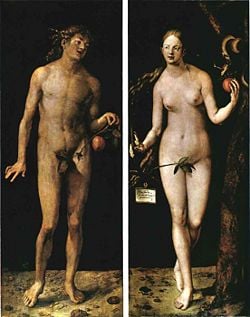
Adam (Hebrew: אָדָם, Adam, "man"; and Eve (Hebrew: חַוָּה, Ḥavva, "living one") were the first man and woman created by God, according to the Bible and the Qur'an.
The story of Adam and Eve is told in the early chapters of the book of Genesis. The main story elements are the creation of man and woman; the temptation and the Fall; the expulsion from Eden; and the subsequent peopling of the world outside the Garden of Eden.
The story of the first human couple underwent extensive elaboration in later Abrahamic traditions, and modern textual scholarship continues to analyze the it several layers and demonstrate its relationship with eariler Sumerian mythology. The story has provided many of the most important symbols in Western culture, including the Tree of the Knowledge of Good and Evil, the forbidden fruit, and the serpent as Satan. It also provides much of the scriptural basis for the doctrine of original sin, a central doctrine in Christianity which is not shared by Judaism and Islam.
Biblical account
The creation of man and woman
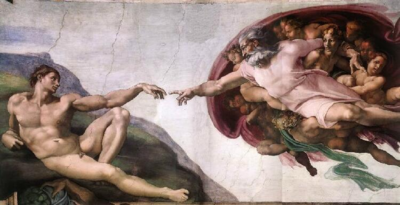
The story of Adam and Eve begins in the first chapter of the Book of Genesis, but they are not refered to here by name. Instead, the text refers to God's deciding to "make man in our image, in our likeness." The creation of man takes place after six "days" of creation in which God first brings into being the heavens and the earth, light, day and night, sky and sea, dry land, trees and other vegetation, the sun and the moon, sea creatures and birds, and finally livestock and wild animals. The manifestation of God's image in "man" is both masculine and feminine:
- So God created man in his own image,
- in the image of God he created him;
- male and female he created them. — Gen. 1:27
God proceeds to bless the couple to "Be fruitful and increase in number; fill the earth and subdue it. Rule over the fish of the sea and the birds of the air and over every living creature that moves on the ground." (Gen. 1:28) God gives them "every tree that has fruit with seed in it" to eat. At the conclusion of this sixth day of creation God declares His work to be "very good" and proceeds to rest on the seventh day.
The account of Genesis 2 is seen by many scholars as a distinct narrative from a different source. Among several differences between the two accounts, God is no longer called Elohim here, but is referred as Yahweh, translated as "the Lord" in most English versions. Here, for the first time, the man and woman are named. Also, in this account, no tree or shrub has yet been made to grow yet. God creates Adam out of clay and places him in the Garden of Eden. Then he causes all kinds of trees to grow in the Garden, including two special trees: the Tree of Life and the Tree of Knowledge of Good and Evil. Here, Adam is not free to eat of any tree he wishes, as in chapter one. Instead God tells Adam that he must not eat of the Tree of the Knowledge of Good and Evil, warning him that "In the day you eat of it, you will die." (Gen. 2:17).
Seeing that Adam is alone, God then creates Eve out of his rib (Gen. 2:22). Adam then names the animals, and calls Eve "woman." They are both "naked and unashamed."
The fall of man
For an unspecified period of time, Adam and Eve obey the one commandment they have been given, to refrain from eating of the forbidden fruit. However, one day, a serpent comes to Eve and seduces her into partaking of it. "God knows that when you eat of it your eyes will be opened," he tells her, "and you will be like God, knowing good and evil." The serpent shows Eve that the fruit is "good for food and pleasing to the eye, and also desirable for gaining wisdom," so she eats it. She then gives some of the fruit to Adam, and he, too, eats. Adam and Eve immediately realize that they are naked, and become of ashamed of this, using fig leaves to cover their sexual organs.
Soon, God walks through the Garden looking for Adam and Eve, but he cannot find them, because they are hiding from Him. God calls out to Adam: "Where are you?" (Gen. 3:9) Adam responds, "I heard your voice, and I was afraid, because I was naked." God then replies: "How did you know you were naked? Did you eat of the fruit of the tree I told you not to eat of?" Adam admits his disobedience but blames it on Eve, and Eve in turn blames it on the serpent.
As a result of these events, God curses all three of the characters in the drama: the serpent must crawl on his belly and eat dust; the woman must suffer increased pain in childbearing and be ruled by her husband; and the man must now labor for his food instead of eating freely of what grows in the Garden, for the land too is cursed.
God recognizes that the serpent's prophecy has come true: "The man has now become like one of us, knowing good and evil." (Gen 3:21) To prevent Adam from also partaking of the Tree of Life and living forever, God casts him out of the Garden, posting cherubim and a flaming sword to guard the entrance.
Life outside of paradise
Adam and Eve now begin their lives outside of Eden and begin to raise a family. Their first child is called Cain, and their second is called Abel. After the grow up to the point of establishing a livelihood for themselves, Cain becomes a farmer, while Abel is a shepherd. Later, the two brothers each offers a sacrifice to God: Cain brings an offering of his crops, while Abel brings an offering of his flocks. God accepts Cain's offering but rejects Abel's. As a result, Cain becomes dejected. God warns Cain that he must overcome his feelings, for he too will be accepted. However, Cain is unable to change his outlook. Instead, he lures Abel into the field and kills him. Cain moved toward the east, where his wife—not previously mentioned—gave birth to Adam and Eve's first grandson, Enoch.
After this, Adam and Eve themselves have another son, Seth, and Eve declares "God has granted me another child in place of Abel, since Cain killed him." After Seth grew to maturity, he became the father Enosh.
A separate account of Adam's lineage is given in Genesis 5. Here, neither Cain's nor Abel's lineage is mentioned. It is therefore presumed that Abel died without children. Here it is specified that Adam was 130 years old when he became the father of Seth. It is also claimed that Adam lived 930 years before he himself died. Although Eve is not mentioned in this genealogy, in Gen. 3:20 she is given the title "the mother of all living." Genesis 5:4 refers to other sons and daughters, but does not name them.
Later Abrahamic traditions
Jewish traditions
Even in ancient times, the presence of two distinct accounts was noted, and regarded with some curiosity. The first account says male and female [God] created them, whereas the second account states that God created Eve from Adam's rib because Adam was lonely. Thus to resolve this apparent discrepancy, some rabbis suggested that Eve and the "woman" of Gen. 1 were two separate individuals.
Preserved in the Midrash, and the mediaeval Alphabet of Ben Sira, this rabbinic tradition held that the first woman, called Lilith, refused to take the submissive position to Adam in sex, and eventually fled from him, consequently leaving him lonely.
In the Talmud, which contains numerous and sometimes contradictory rabbinical traditions, Adam is said to have separated from Eve for 130 years, during which time his ejaculations gave rise to ghouls, and demons. Elsewhere, Lilith is identified as the mother of these creatures. The demons were said to prey on newborn males before they had been circumcised, and so a tradition arose in which a protective amulet was placed around the neck of newborns. Traditions in the Midrash concerning Lilith, and her sexual appetite, have been compared to Sumerian mythology concerning the demon ki-sikil-lil-la-ke, by scholars who postulate an intermediate Akkadian folk etymology interpreting the lil-la-ke portion of the name as a corruption of lîlîtu, a female storm demon originating in Sumer.
The Alphabet of Ben Sira identifies a third wife, created after Lilith deserted Adam but before Eve. This unnamed wife was purportedly made in the same way as Adam, from the "dust of the earth," but the sight of her being created proved too much for Adam to take and he refused to go near her.
Genesis does not say how long Adam and Eve were in the Garden of Eden, but the Book of Jubilees states that they were removed from the garden on the new moon of the fourth month of the eighth year after creation (Jubilees 3:33). Other Jewish sources, however, assert that it was less than a day.
Another Jewish tradition — also used to explain "male and female He created them" line, is that God originally created Adam as a hermaphrodite (Midrash Rabbah, Genesis 7:1) and in this way was both male and female. God later decided that "it is not good for him to be alone," and brought the feminine Eve out of Adam, leaving Adam as masculine only and thus creating the idea of two people joining together to achieve a union of the two separate spirits.
Only three of Adam's children (Cain, Abel, and Seth) are explicitly named in Genesis. In Jubilees, two daughters are named: Azûrâ and Awân. Nine other sons are also mentione, besides Seth, Cain, Abel, making 12 sons and two daughters in all. Jubilees goes on to state that Cain later married Awân and Seth married Azûrâ. However, according other Jewish traditions, Cain had a twin sister named Lebuda, and Abel a twin sister named Qelimath. In the Conflict of Adam and Eve with Satan, Cain's twin sister is named Luluwa, and Abel's twin sister is named Aklia. Other apocrypthal accounts give further details of Adam and Eve's life outside of Eden, in particular, the Life of Adam and Eve (also known as the Apocalypse of Moses).
As the first man, Adam was traditionally a significant figure to whom was attributed prophecy and wisdom. Some traditions hold that Adam and Eve are currently buried in the Cave of Machpelah, in Hebron, along with many of the great Jewish patriarchs and matriarchs.
Christianity
The story of Adam and Eve forms the basis for the Christian doctrine of original sin: "Sin came into the world through one man and death through sin, and so death spread to all men because all men sinned," said Paul of Tarsus in his Epistle to the Romans, writing in Greek about 58 C.E.[1]
St Augustine of Hippo (354-430), working with a Latin translation of the epistle, understood Paul to have said that Adam's sin was hereditary: "Death passed upon (i.e. spread to) all men because of Adam, [in whom] all sinned".[2] Original sin, the concept that man is born in a condition of sinfulness and must await redemption, became a cornerstone of Christian theological tradition, primarily in Western-rite churches, but is not shared by Judaism, the Orthodox churches,[3] nor by post-Reformation churches such as the Congregationalist churches, nor The Church of Jesus Christ of Latter-day Saints. Over the centuries, a system of uniquely Christian beliefs has developed from the Adam and Eve story. Baptism has become understood as a means of washing away the stain of hereditary sin in some churches. In other branches of Christianity, baptism is a means of washing away sins that were actually committed by the person being baptised. It is an identification with the death, burial and resurrection of Jesus Christ.
It is a ceremony of spiritually washing one in the blood of the Savior, which was shed on the cross. In still other Christian traditions, this process is merely seen as a symbol of faith and also an initiation, or a public declaration of faith.[4] Additionally, the serpent that tempted Eve was interpreted by some to have been Satan, although there is no mention of this identification in the Torah. Christian interpretations of the Scripture are often considered more literal than Jewish interpretations.
Because Eve had tempted Adam to eat of the fatal fruit, some early Fathers of the Church held her and all subsequent women to be the first sinners, and especially responsible for the Fall. "You are the devil's gateway," Tertullian told his female listeners in the early 2nd century, and went on to explain that they were responsible for the death of Christ: "On account of your desert _ that is, death - even the Son of God had to die."[5] In 1486 the Dominicans Kramer and Sprengler used similar tracts to justify the Malleus Maleficarum ("Hammer of the Witches") that led to three centuries of persecution of "witches".
Eastern Orthodox tradition holds that the sword placed at the entrance to Paradise to prevent humankind from returning to the Garden was removed once Jesus was born.
Liberal Christians teach that many parts of the Bible should not be taken literally. The story of Adam & Eve may be included.
- See also: Harrowing of Hell
Gnostic and Manichaean traditions
In certain forms of Christian Gnosticism the creation of Adam as Protanthropos—the original man, had a very important place. As in some rabbinial traditions, the Apocalypse of Adam suggests that man and woman were originally conjoined in a single androgynous being, both male and female. This primordeal "man" was greater than the eternal angels and higher even than Samael, the god of the Aeon and Powers that had created them. Samael, then separated the male Adam from the female Eve, causing their superior knowledge of God to flee from them. The Protanthropos is also sometimes seen as a spiritual emanation from God, called the Son of God, which appeared to mankind as Jesus.
In a similar vein, though without reference to the above cosmology, the Gospel of Thomas quotes Jesus as saying: "When you make the two into one, and when you make the inner like the outer and the outer like the inner, and the upper like the lower, and when you make male and female into a single one... then you will enter [the kingdom]."
In the Manichaean belief the "Fall" is then seen as the primordial man being and swallowed in darkness and association with the material world. The Protanthropos here is seen as "the World Soul" (Anima Mundi), sent to fight against darkness.
Some Gnostics adtopted the Marcionite belief that the wrathful Yahweh of the Old Testament and the loving Heavenly Father of Jesus were two separate divinities. Gnostic accounts—particularly those of the Ophites—also turned the identification of the serpent with Satan on its head, seeing the serpent as the hero who was trying to help the first couple gain knowledge to defeat Samael, whom some Gnostics saw as the jealous demiurge of the creation.
Islamic tradition
The Qur'an tells of آدم (ʾĀdam) in the surahs al-Baqara 2:30-39, al-A'raf 7:11-25, al-Hijr 15:26-44, al-Isra 17:61-65, Ta-Ha 20:115-124, and Sad 38:71-85. When God orders the angels to bow to Adam one of those present, the Jinni Iblis refuses, due to his pride, and assumes the role of Shaitan, the tempter.
Eve is not mentioned by name in the Qur'an, although it is presumably she who is referred to as Adam's spouse. Islamic tradition refers to her by an etymologically similar name - حواء (Hawwāʾ). In the Islamic tradition, Adam and Eve do eat of the forbidden, but they immediately repent of their sin. As one of the people to whom God is said to have spoken to directly, Adam is seen as a prophet in Islam and thus committed no sin after his repentence, nor did the sin of the first couple create a "fallen nature" in their descendants. The Qur'an also describes the two sons of Adam—named Qabil and Habil in Islamic tradition, but not mentioned by name in the Qur'an—that correspond to Cain and Abel.
The early Islamic commentator Muhammad ibn Jarir al-Tabari adds a number of other details.[6] According to Tabari's account, after receiving the breath of God, Adam remained a dry body for 40 days, then gradually came to life from the head downwards, sneezing when he had finished coming to life.
The Shiite commentator Al-Qummi records the opinion that Eden was not entirely earthly. Having been sent to earth, Adam and Eve first arrived at mountain peaks outside Mecca—Adam on Safa, and Eve on Marwa. In this tradition, Adam remained weeping for 40 days, until he repented, at which point God rewarded him by sending down the Kaaba, and teaching him to perform the Islamic duty of the the Hajj. Other Islamic traditions hold that Adam was moved to Sri Lanka, as the next best thing to Eden.
Historicity
Adam and Eve are considered in evangelical Christianity and Orthodox Judaism as real historical people. Genesis 5:4 records Adam within a genealogy, in the biblical tradition all human beings are descended from Adam and Eve. Ten generations later, Noah and his wife became the new progenitors of mankind after the Flood.
However, many modern biblical scholars consider the story of Adam and Eve as an example of a myth, whose importance is in the lessons it conveys rather than the historical reality it supposedly describes. In this interpretation, the narrative's purpose is to convey origin of sin and human rebellion against God, as well as several less important truths, such as:
- why people are ashamed of being naked
- why people die
- why the snake crawls on its belly
- why women suffer so much during childbirth
- why men must work hard to make a living
- why shepherds and farmers don't get along with each other
- why God prefers animal sacrifices to grain sacrifices
The historical-critical school of biblical interpretation emphasizes that the two stories of Adam and Eve in Genesis 1 and Genesis 2 are actually quite different from one another. In the first story, derived from Babylonian creation myths, there the world is "good," man and woman are "very good," God blesses the first couple to be fruitful and multiply, and there is no commandemnt to refrain from eating from any of the trees of creation. In the second story, probably designed in opposition to Canaanite mother-goddess worship, a certain fruit is forbidden, an evil serpent lurks in the Garden waiting to tempt Eve to sin against God, and the world is not "very good" after all.
In modern times the theory of evolution has also challenged the Christian belief in the historicity of Adam and Eve. Many denominations no longer insist that Adam and Eve were the literal parents of humankind, while others have retained a belief that the story is true as written. However, geneticists have recently identified individuals dubbed "Y-chromosomal Adam" and "Mitochondrial Eve." Howeer, these two individuals are not thought by the scientific community to be the biblical Adam and Eve. Mitochondrial Eve—the common matrilineal ancestor of all humans alive today—lived many millenia before Y-chromosomal Adam.
Notes
- ↑ Later theological commentators characterised Adam and Eve's disobedience to God's word as the foundation of sin. Nevertheless, Chapter 3 of Genesis does not use the word "sin", and Genesis 3:24 makes clear that they are expelled "lest he put forth his hand and take also of the tree of life, and eat, and live for ever".
- ↑ For a brief overview see Robin Lane Fox, "The Unauthorized Version", 1991, pp15-27 passim
- ↑ Orthodox beliefs
- ↑ Original Sin
- ↑ Tertullian, "De Cultu Feminarum", Book I Chapter I, Modesty in Apparel Becoming to Women in Memory of the Introduction of Sin Through a Woman (in "The Ante-Nicene Fathers")
- ↑ On The Transmitters Of Isra'iliyyat
ReferencesISBN links support NWE through referral fees
- Mahmoud Ayoub, The Qur'an and its Interpreters, SUNY: Albany, 1984.
- R. Patai, The Jewish Alchemists, Princeton University Press, 1994.
- Fazale Rana and Ross, Hugh, Who Was Adam: A Creation Model Approach to the Origin of Man, 2005, ISBN 1-57683-577-4
- Sibylline Oracles, III; 24-6. This Greek acrostic also appears in 2 Enoch 30:13.
- David Rohl, Legend: The Genesis of Civilisation, 1998
- Bryan Sykes, The Seven Daughters of Eve
- C.S. Lewis, The Lion, The Witch and the Wardrobe"
- Adam Mackie, The Importance of being Adam - Alexo 1997 (only 2000 copies published)
- Robin Lane Fox, "The Unauthorized version", Penguin, 1991 (no ISBN available)
See also
- Adam (prophet of Islam)
- Adam and Eve (Mormonism)
- Conflict of Adam and Eve with Satan
- Creation narrative
- Garden of Eden
- Generations of Adam
- Kaliyan
- Mitochondrial Eve
- Pre-Adamite
- Similarities between the Bible and the Qur'an
- Tree of Life
- Tree of Knowledge of Good and Evil
- Y-chromosomal Adam
- The Holy Bible
External links
- First Human Beings (Library of Congress)
- The Story of Lilith in The Alphabet of Ben Sira
- Islamic view of the fall of Adam (audio)
- Chromosome dating
Credits
New World Encyclopedia writers and editors rewrote and completed the Wikipedia article in accordance with New World Encyclopedia standards. This article abides by terms of the Creative Commons CC-by-sa 3.0 License (CC-by-sa), which may be used and disseminated with proper attribution. Credit is due under the terms of this license that can reference both the New World Encyclopedia contributors and the selfless volunteer contributors of the Wikimedia Foundation. To cite this article click here for a list of acceptable citing formats.The history of earlier contributions by wikipedians is accessible to researchers here:
The history of this article since it was imported to New World Encyclopedia:
Note: Some restrictions may apply to use of individual images which are separately licensed.
